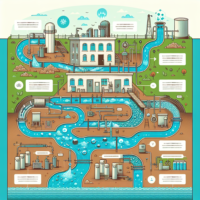Forever Chemicals
Forever Chemicals: Understanding, Mitigation, and the Path Forward
Introduction
In the evolving landscape of environmental science and public health, “forever chemicals” have emerged as a critical concern for governments, industries, and communities alike. These substances—predominantly per- and polyfluoroalkyl substances (PFAS)—are notorious for their persistence in the environment and human body, leading to serious health implications and regulatory challenges. For municipal directors, environmental engineers, and plant operators, understanding and addressing the complexities of forever chemicals is not merely an environmental issue but a public health priority.
Understanding Forever Chemicals
What Are Forever Chemicals?
Forever chemicals is a colloquial term for a group of synthetic chemicals known as PFAS. These fluorinated compounds are characterized by carbon-fluorine bonds, which are among the strongest in organic chemistry, resulting in extraordinary resistance to heat, water, and oil. A 2023 report by the Environmental Protection Agency (EPA) estimated that over 9,000 different PFAS compounds exist, being utilized in various applications, including firefighting foams, non-stick cookware, and water-repellent fabrics.
Why They Matter
The significance of forever chemicals lies in their persistence. PFAS do not break down easily in the environment, leading to bioaccumulation. Research has indicated that nearly 99% of Americans have detectable levels of PFAS in their blood, according to studies published by the Centers for Disease Control and Prevention (CDC) in 2024. Exposure has been linked to numerous health issues, including cancer, thyroid disease, and reproductive harm, making it vital for stakeholders to understand both implications and remedies.
Regulatory Landscape
Current Regulations on PFAS: A 2025 Perspective
As of 2025, the regulatory landscape surrounding forever chemicals is rapidly evolving. The EPA has ramped up its efforts to regulate PFAS, proposing the first national drinking water standards specifically targeting PFOA and PFOS—two of the most studied PFAS. These regulations aim to limit concentrations to 4 parts per trillion, reflecting an unprecedented approach to managing contaminants in drinking water.
State-level regulations have also been instituted, with initiatives in places like California and Michigan mandating the testing and reduction of PFAS in drinking water supplies. Furthermore, the bi-partisan government initiative dubbed the “PFAS Action Plan” has outlined a comprehensive strategy for managing these contaminants through monitoring, research, and community engagement.
Challenges in Enforcement
While regulations are becoming more stringent, enforcement remains a substantial challenge. Many municipal facilities lack the necessary infrastructure to adequately monitor and address PFAS levels, amplifying the risk of public health crises. Moreover, legal challenges regarding liability and remediation costs complicate efforts to manage these harmful substances.
The Science Behind PFAS: Health Impacts and Risks
Health Risks Associated with Exposure
Studies have shown that even low levels of PFAS exposure are linked to serious health risks. Research from industry analyses in 2024 indicated connections between PFAS exposure and various forms of cancer, particularly kidney and testicular cancer. Furthermore, a comprehensive review in the International Journal of Environmental Health in 2025 underscored the links to developmental effects in children, including low birth weights and delayed immunological responses.
Public Awareness and Perception
As research continues to emerge, public awareness around forever chemicals has increased. A nationwide survey conducted by the Pew Research Center in early 2025 found that 76% of Americans view PFAS as a significant health risk. This growing concern presents an opportunity for communities and stakeholders to engage in dialogues that educate about safe practices and remedial actions.
Mitigation Strategies: Addressing Forever Chemicals
Water Treatment Options
Considering the persistent nature of PFAS, effective water treatment solutions are paramount. Several methods have been proven effective in removing PFAS from water sources, including:
-
Granular Activated Carbon (GAC): GAC filters are effective in adsorbing various PFAS compounds. A 2024 study revealed that GAC could remove about 90% of PFOA and PFOS when designed and operated correctly.
-
Reverse Osmosis (RO): RO systems are capable of removing up to 99% of PFAS compounds. However, they require substantial operational costs and energy inputs, making them less accessible for some municipalities.
-
Ion Exchange Resins: Emerging technologies utilizing ion exchange resins specifically designed for PFAS removal show promise. These systems offer a more selective adsorption process, thereby enhancing removal efficiency.
Source Control: The Role of Industries
Additionally, source control is critical. Industries generating PFAS waste must implement rigorous practices and technologies to mitigate their discharge. This includes upgrading production processes and investing in research and development of alternatives that are less harmful to the environment.
Community Engagement and Education
Community involvement is vital in combatting PFAS pollution. Municipal directors and plant operators should facilitate outreach programs raising awareness about PFAS, encouraging residents to understand testing results and their implications. Open forums can foster trust and empower communities to engage in policy advocacy at both local and state levels.
Technological Innovations and Future Directions
Emerging Treatments
Innovations are continuously evolving in PFAS remediation technologies. For example, researchers at a leading environmental institute are investigating advanced oxidation processes that could degrade PFAS compounds effectively. Similarly, bio-remediation strategies utilizing specialized microorganisms to break down PFAS substances are under development, showing promise for future applications.
Policy Development and International Standards
Looking forward, the establishment of international PFAS standards is imperative. Collaboration among global leaders to set globally recognized thresholds would simplify regulatory compliance for multinational corporations. The sharing of data and resources could also boost research and remediation efforts on a wide scale.
Conclusion
The challenge of forever chemicals is multifaceted, involving public health, environmental impact, and regulatory compliance. As an environmental engineer, it is clear that a proactive, knowledgeable approach can provide solutions to mitigate these risks. Understanding the implications of PFAS, adhering to evolving regulations, and employing innovative strategies will empower municipalities and industries to safeguard public health and environmental integrity. Engaging in continuous education and community outreach will further enhance efforts to combat these persistent pollutants, ensuring a healthier future for generations to come.
By collaborating with stakeholders across disciplines, we can pave the way for sustainable practices that protect both our environment and public health from the lasting effects of forever chemicals.


